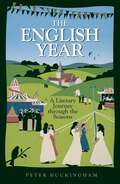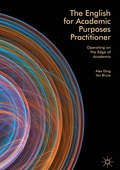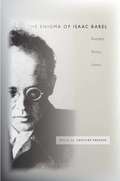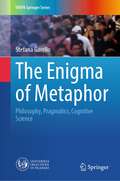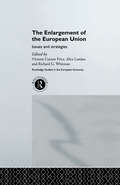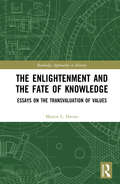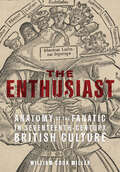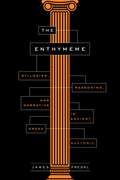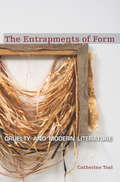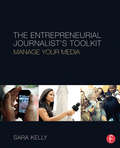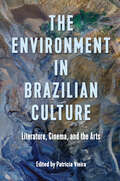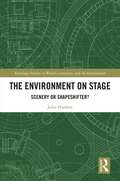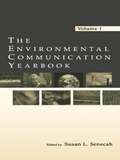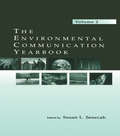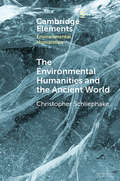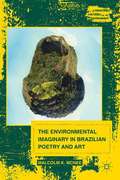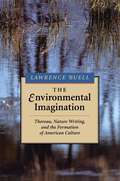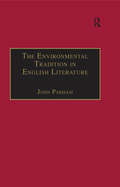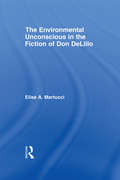- Table View
- List View
The English Year: A Literary Journey Through the Seasons
by Peter BuckinghamJoin some of England’s best-loved writers in this day-by-day celebration of an English year. Diary entries by literary figures such as Gilbert White and Thomas Hardy guide us through the year, accompanied by poems and quotations celebrating the changing seasons, and passages explaining the origins of some of our oldest festive traditions.
The English Year: A Literary Journey Through the Seasons
by Peter BuckinghamJoin some of England’s best-loved writers in this day-by-day celebration of an English year. Diary entries by literary figures such as Gilbert White and Thomas Hardy guide us through the year, accompanied by poems and quotations celebrating the changing seasons, and passages explaining the origins of some of our oldest festive traditions.
The English for Academic Purposes Practitioner
by Alex Ding Ian BruceThis book contextualizes the field of English for Academic Purposes (EAP), with a particular focus on the professional and academic identity and role of the EAP practitioner. The authors examine previously neglected areas such as the socio-economic, academic and employment contexts within which EAP practitioners function. In doing so, they develop a better understanding of the roles, expectations and constraints that arise from these contexts, which in turn shape professional practice and the identity of the practitioner. As EAP is emerging as an academic discipline with a growing body of published research, this book will appeal to trainee and established practitioners, along with researchers and students of linguistics and education.
The Englishized Subject: Postcolonial Writings In Hong Kong, Singapore And Malaysia
by Kwok-Kan TamThis book addresses issues of how the cultures in Hong Kong, Singapore and Malaysia have been Englishized in postcolonial and globalized contexts, not just in terms of language, but also in writers’/people’s subjectivity. Taking a cultural-literary approach to the study of Englishized subjectivity, the book offers a unique study of hybridized literary/language forms by relating them to bilingual thinking and bicultural sensibility. Poets, novelists and playwrights have different strategies to cope with new images and new forms of expression that can capture their sense of hybridized identity, and as a result, hybridity becomes creativity.
The Enigma of Isaac Babel
by Gregory FreidinFreidin (Slavic languages and literature, Stanford U. ) presents 12 papers exploring the life and work of Soviet writer Isaac Babel (1894-1940), who produced a number of short stories, two plays, and various newspaper articles before he became a victim of the Stalinist purges. The papers reconstruct his biography; place his writings in the context of the turbulent political, cultural, and social circumstances of the first decades following the Russian Revolution; and conduct analyses of more specifically literary issues, such as Babel's debt to Flaubert and his use of linguistic elements of Russian, Yiddish, and Hebrew in his works. Annotation c2010 Book News, Inc. , Portland, OR (booknews. com)
The Enigma of Metaphor: Philosophy, Pragmatics, Cognitive Science (UNIPA Springer Series)
by Stefana GarelloThis book deals with the complicated realm of metaphor, an enigma deeply embedded in language and cognition. There has been much discussion of metaphor in the past, but it was characterized by a certain fragmentation and lacked interdisciplinarity. In this field of study, the dominance of Cognitive Linguistics, epitomized by the Conceptual Metaphor Theory of George Lakoff and Mark Johnson, has caused the marginalization of alternative perspectives. To fill this gap, this book embarks on an interdisciplinary journey, inviting different theoretical frameworks to engage in a fruitful dialog. It navigates the labyrinth of theories and illuminates the nuanced facets of metaphor.At the center of this exploration are three central questions: whether metaphor belongs to the realm of style or thought, the intricate interplays between literal and metaphorical meanings and the integration of propositional and non-propositional elements in the construction of metaphorical meaning.Through a careful blend of historical analysis and contemporary hypotheses, the book unravels the complexities of metaphor, considering its evolution across the centuries and the myriad interpretations it evokes. By bringing together work from different fields, it ultimately shows that a definition of metaphor is theory-dependent and that metaphor is not a natural kind, but a complex and multifaceted philosophical concept whose study requires a multi-dimensional approach that transcends narrow theoretical boundaries. In this way, the book explores these considerations’ most important philosophical consequences and offers new insights into this fundamental aspect of human language.
The Enlargement of the European Union: Issues and Strategies (Routledge Studies in the European Economy)
by Richard G. Whitman Alice Landau Victoria Curzon PriceThis volume looks at the process of enlargment which the European Union is currently undertaking, focusing on both the economic and political dimensions of the subject. The volume examines how enlargment has evolved and looks at the roles and relations of the different actors - member states, applicant states and EU institutions. With contributors coming from different disciplinary backgrounds, the volume offers an unusually rich array of perspectives on one of the most significant political developments of recent years.
The Enlightenment and the Fate of Knowledge: Essays on the Transvaluation of Values (Routledge Approaches to History)
by Martin L. DaviesThe Enlightenment is generally painted as a movement of ideas and society lasting from the late seventeenth to the early nineteenth century, but this book argues that the Enlightenment is an essential component of modernity itself. In the course of the study, Martin Davies offers an original world-view and a critique of some recent interpretations of the Enlightenment.
The Enthusiast: Anatomy of the Fanatic in Seventeenth-Century British Culture
by William Cook MillerThe Enthusiast tells the story of a character type that was developed in early modern Britain to discredit radical prophets during an era that witnessed the dismantling of the Church of England's traditional means for punishing heresy. As William Cook Miller shows, the caricature of fanaticism here called the Enthusiast began as propaganda against religious dissenters, especially working-class upstarts, but was adopted by a range of writers as a literary vehicle for exploring profound problems of spirit, soul, and body and as a persona for the ironic expression of their own prophetic illuminations. Taking shape through the public and private writings of some of the most insightful authors of seventeenth-century Britain—Henry More, John Locke, the Third Earl of Shaftesbury, Mary Astell, and Jonathan Swift, among others—the Enthusiast appeared in various guises and literary modes. By attending to this literary being and its animators, The Enthusiast establishes the figure of the fanatic as a bridge between the Reformation and the Enlightenment, showing how an incipient secular modernity was informed by not the rejection of religion but the transformation of the prophet into something sparkling, witty, ironic, and new.
The Enthymeme: Syllogism, Reasoning, and Narrative in Ancient Greek Rhetoric
by James FredalCentral to rhetorical theory, the enthymeme is most often defined as a truncated syllogism. Suppressing a premise that the audience already knows, this rhetorical device relies on the audience to fill in the missing information, thereby making the argument more persuasive. James Fredal argues that this view of the enthymeme is wrong. Presenting a new exegesis of Aristotle and classic texts of Attic oratory, Fredal shows that the standard reading of Aristotle’s enthymeme is inaccurate—and that Aristotle himself distorts what enthymemes are and how they work.From close analysis of the Rhetoric, Topics, and Analytics, Fredal finds that Aristotle’s enthymeme is, in fact, not syllogistic and is different from the enthymeme as it was used by Attic orators such as Lysias and Isaeus. Fredal argues that the enthymeme, as it was originally understood and used, is a technique of storytelling, primarily forensic storytelling, aimed at eliciting from the audience an inference about a narrative. According to Fredal, narrative rather than formal logic is the seedbed of the enthymeme and of rhetoric more broadly.The Enthymeme reassesses a fundamental doctrine of rhetorical instruction, clarifies the viewpoints of the tradition, and presents a new form of rhetoric for further study and use. This groundbreaking book will be welcomed by scholars and students of classical rhetoric, the history of rhetoric, and rhetorical theory as well as communications studies, classical studies, and classical philosophy.
The Enthymeme: Syllogism, Reasoning, and Narrative in Ancient Greek Rhetoric
by James FredalCentral to rhetorical theory, the enthymeme is most often defined as a truncated syllogism. Suppressing a premise that the audience already knows, this rhetorical device relies on the audience to fill in the missing information, thereby making the argument more persuasive. James Fredal argues that this view of the enthymeme is wrong. Presenting a new exegesis of Aristotle and classic texts of Attic oratory, Fredal shows that the standard reading of Aristotle’s enthymeme is inaccurate—and that Aristotle himself distorts what enthymemes are and how they work.From close analysis of the Rhetoric, Topics, and Analytics, Fredal finds that Aristotle’s enthymeme is, in fact, not syllogistic and is different from the enthymeme as it was used by Attic orators such as Lysias and Isaeus. Fredal argues that the enthymeme, as it was originally understood and used, is a technique of storytelling, primarily forensic storytelling, aimed at eliciting from the audience an inference about a narrative. According to Fredal, narrative rather than formal logic is the seedbed of the enthymeme and of rhetoric more broadly.The Enthymeme reassesses a fundamental doctrine of rhetorical instruction, clarifies the viewpoints of the tradition, and presents a new form of rhetoric for further study and use. This groundbreaking book will be welcomed by scholars and students of classical rhetoric, the history of rhetoric, and rhetorical theory as well as communications studies, classical studies, and classical philosophy.
The Entrapments of Form: Cruelty and Modern Literature
by Catherine ToalArguing that cruelty acquires a new meaning in modernity, The Entrapments of Form follows its evolution through exchanges between French and American literature over the contradictions of Enlightenment (slavery, genocide, libertine aristocratic privilege). Catherine Toal traces Edgar Allan Poe’s influence on the Sadean legacy, Melville’s fictional dramatization of Tocqueville, and Henry James’s response to the aesthetic of his French contemporaries, including Flaubert. The result is not simply a work that provides close readings of key literary texts of the nineteenth century—Benito Cereno, The Turn of the Screw, Les Chants de Maldoror—but one that shows how in this era cruelty develops a specific narrative structure, one that is confirmed by the manner of its negation in twentieth-century philosophy. The final chapters address this shift: the postwar French reception of Sade and the relationship between American cultural theory and the rhetoric of the so-called war on terror.
The Entrepreneurial Journalist’s Toolkit: Manage Your Media
by Sara KellyToday's journalism and communication students need the tools to develop and maintain their own media businesses and freelance careers. In addition to mastering the basics of converged journalism practice, they need training in business entrepreneurship, mass communication and business law, and career and reputation management. The Entrepreneurial Journalist's Toolkit provides a solid foundation of multimedia journalism and also teaches readers to create solid business plans and develop funding proposals while maintaining high legal and ethical standards. This book details the process of pitching and working with clients, managing multi-platform communication campaigns to maximize reach, keeping the books, and filing taxes. It is provides everything a new or experienced journalist needs to get started as a media entrepreneur.
The Environment in Brazilian Culture: Literature, Cinema, and the Arts
by Patricia VieiraExamining Brazilian artists’ engagement with the natural world from 1900 to the present The Environment in Brazilian Culture explores the centrality of the natural world in shaping Brazilian literature, cinema, and art since 1900. This collection, exceptional in its representation of material from diverse locations and cultures within Brazil, as well as in its investigation of a range of artistic mediums and genres, portrays the human connection to nature in the most biodiverse country in the world. From the forests of the Amazon to the mountains of the Serra do Mar, this volume examines Brazilian depictions of different geographical regions and the plants and animals found in each. Contributors pay particular attention to the environment’s integral place in Indigenous identity and art. They also discuss artistic references to environmental devastation, underscoring the connection between ecological degradation and contemporary socioeconomic inequality. Works discussed in these chapters include novels by Itamar Vieira Junior and Maria José Silveira, poetry by Marília Floôr Kosby, Guarani and Bororo verbal arts, Huni Kuĩ documentary films, and paintings by Candido Portinari.These wide-ranging analyses highlight the value of Brazilian cultural production to critical plant and animal studies, posthumanism, and the environmental humanities. And, in grappling with Brazil’s extractivist past, they search for alternatives to a predatory approach to the land and its inhabitants, looking for pathways to environmental justice in the Anthropocene. Contributors: Victoria Saramago | Leila Lehnen | Rex P. Nielson | Maria Esther Maciel | Valeria Meiller | Benjamin Burt | Juliana Luna Freire | Nuno Marques | Cinthya Torres | Jens Andermann | Malcolm K. McNee | Patricia Isabel Lontro Marder Vieira | Martiniano Alcantara Neto
The Environment on Stage: Scenery or Shapeshifter? (Routledge Studies in World Literatures and the Environment)
by Julie HudsonThe Environment on Stage: Scenery or Shapeshifter? investigates a pertinent voice of theatrical performance within the production and reception of ecotheatre. Theatre ecologies, unavoidably enmeshed in the environment, describe the system of sometimes perverse feedback loops running through theatrical events, productions, performances and installations. This volume applies an ecoaware spectatorial lens to explore live theatre as a living ecosystem in a literal sense. The vibrant chemistry between production and reception, and the spiralling ideas and emotions this generates in some conditions, are unavoidably driven by flows of matter and energy, thus, by the natural environment, even when human perspectives seem to dominate. The Environment on Stage is an intentionally eclectic mix of observation, close reading and qualitative research, undertaken with the aim of exploring ecocritical ideas embedded in ecotheatre from a range of perspectives. Individual chapters identify productions, performances and installations in which the environment is palpably present on stage, as it is in natural disasters such as floods, storms, famine, conflict and climate change. These themes and others are explored in the context of site-specificity, subversive spectators, frugal modes of narrative, the shifting ‘stuff’ of theatre productions, and imaginative substitutions. Ecotheatre is nothing less than vibrant matter that lets the environment speak for itself
The Environmental Communication Yearbook: Volume 1
by Susan L. SenecahEditorial ScopeThe Environmental Communication Yearbook is a multidisciplinary forum through which a broad audience of academics, professionals, and practitioners can share and build theoretical, critical, and applied scholarship addressing environmental communication in a variety of contexts. This peer-reviewed annual publication invites submissions that showcase and/or advance our understanding of the production, reception, contexts, or processes of human communication regarding environmental issues. Theoretical expositions, literature reviews, case studies, cultural and mass media studies, best practices, and essays on emerging issues are welcome, as are both qualitative and quantitative methodologies. Areas of topical coverage will include:*participatory processes: public participation, collaborative decision making, dispute resolution, consensus building processes, regulatory negotiations, community dialogue, building civic capacity;*journalism and mass communications: newspaper, magazine, book and other forms of printed mass media; advertising and public relations; media studies; and radio, television, and Internet broadcasting; and*communication studies: rhetorical/historical case studies, organizational analyses, public relations/issues management, interpersonal/relational dimensions, risk communication, and psychological/cognitive research, all of which examine the origins, content, structure, and outcomes of discourse about environmental issues. Submissions are accepted on an ongoing basis for inclusion in volumes published annually. AudienceResearchers, scholars, students and practitioners in environmental communication, journalism, rhetoric, public relations, mass communication, risk analysis, political science, environmental education, environmental studies, public administrations; policymakers; others interested in environmental issues and the communication channels used for discourse and information dissemination on the topic.For more information and guidelines for submissions, visit www.erlbaum.com/ecy.htm.
The Environmental Communication Yearbook: Volume 2
by Susan L. SenecahEditorial ScopeThe Environmental Communication Yearbook is a multidisciplinary forum through which a broad audience of academics, professionals, and practitioners can share and build theoretical, critical, and applied scholarship addressing environmental communication in a variety of contexts. This peer-reviewed annual publication invites submissions that showcase and/or advance our understanding of the production, reception, contexts, or processes of human communication regarding environmental issues. Theoretical expositions, literature reviews, case studies, cultural and mass media studies, best practices, and essays on emerging issues are welcome, as are both qualitative and quantitative methodologies. Areas of topical coverage will include:*participatory processes: public participation, collaborative decision making, dispute resolution, consensus building processes, regulatory negotiations, community dialogue, building civic capacity;*journalism and mass communications: newspaper, magazine, book and other forms of printed mass media; advertising and public relations; media studies; and radio, television, and Internet broadcasting; and*communication studies: rhetorical/historical case studies, organizational analyses, public relations/issues management, interpersonal/relational dimensions, risk communication, and psychological/cognitive research, all of which examine the origins, content, structure, and outcomes of discourse about environmental issues. Submissions are accepted on an ongoing basis for inclusion in volumes published annually. AudienceResearchers, scholars, students and practitioners in environmental communication, journalism, rhetoric, public relations, mass communication, risk analysis, political science, environmental education, environmental studies, public administrations; policymakers; others interested in environmental issues and the communication channels used for discourse and information dissemination on the topic.For more information and guidelines for submissions, visit www.erlbaum.com/ecy.htm.
The Environmental Communication Yearbook: Volume 3
by Stephen P. DepoeFirst Published in 2006. For scholars and students in environmental communications, journalism, rhetoric, PR, mass communication and other related areas.
The Environmental Humanities and the Ancient World: Questions and Perspectives (Elements in Environmental Humanities)
by Christopher SchliephakeWhat can a study of antiquity contribute to the interdisciplinary paradigm of the environmental humanities? And how does this recent paradigm influence the way we perceive human-'nature' interactions in pre-modernity? By asking these and a number of related questions, this Element aims to show why the ancient tradition still matters in the Anthropocene. Offering new perspectives to think about what directions the ecological turn could take in classical studies, it revisits old material, including ancient Greek religion and mythology, with central concepts of contemporary environmental theory. It also critically engages with forms of classical reception in current debates, arguing that ancient ecological knowledge is a powerful resource for creating alternative world views.
The Environmental Imaginary In Brazilian Poetry And Art
by Malcolm K. McneeThis study contributes to ongoing discussions on the connections between the environmental imaginary and issues of identity, place and nation. Utilizing a delimited ecocritical approach, McNee puts Brazilian culture, through the work of contemporary poets and visual artists, into a broader, transnational dialogue.
The Environmental Imagination: Thoreau, Nature Writing and the Formation of American Culture
by Lawrence BuellThe author provides a major new understanding of Thoreau's achievement and, at the same time, a profound rethinking of our literary and cultural reflections on nature.
The Environmental Imagination: Thoreau, Nature Writing, and the Formation of American Culture (Wiley-blackwell Manifestos Ser.)
by Lawrence BuellWith the environmental crisis comes a crisis of the imagination, a need to find new ways to understand nature and humanity's relation to it. This is the challenge Lawrence Buell takes up in The Environmental Imagination, the most ambitious study to date of how literature represents the natural environment. With Thoreau's Walden as a touchstone, Buell gives us a far-reaching account of environmental perception, the place of nature in the history of western thought, and the consequences for literary scholarship of attempting to imagine a more "ecocentric" way of being. In doing so, he provides a major new understanding of Thoreau's achievement and, at the same time, a profound rethinking of our literary and cultural reflections on nature. The green tradition in American writing commands Buell's special attention, particularly environmental nonfiction from colonial times to the present. In works by writers from Crevecoeur to Wendell Berry, John Muir to Aldo Leopold, Rachel Carson to Leslie Silko, Mary Austin to Edward Abbey, he examines enduring environmental themes such as the dream of relinquishment, the personification of the nonhuman, an attentiveness to environmental cycles, a devotion to place, and a prophetic awareness of possible ecocatastrophe. At the center of this study we find an image of Walden as a quest for greater environmental awareness, an impetus and guide for Buell as he develops a new vision of environmental writing and seeks a new way of conceiving the relation between human imagination and environmental actuality in the age of industrialization. Intricate and challenging in its arguments, yet engagingly and elegantly written, The Environmental Imagination is a major work of scholarship, one that establishes a new basis for reading American nature writing.
The Environmental Tradition in English Literature
by John ParhamDrawing upon the English literary tradition for new perspectives and paradigms, this collection presents a broad range of theoretical and historical approaches to ecocriticism. The first section of the volume offers different theoretical frameworks for ecocritical work, encompassing a range of socio-political, post-modern and multi-disciplinary approaches. In the second section, contributors explore the ways in which ecocriticism allows us to re-think literary history.
The Environmental Unconscious in the Fiction of Don DeLillo (Studies in Major Literary Authors)
by Elise MartucciThis book presents an ecocritical reading of DeLillo’s novels in an attempt to mediate between the seemingly incompatible influences of postmodernism and environmentalism. Martucci argues that although DeLillo is responding to and engaging with a postmodern culture of simulacra and simulation, his novels do not reflect a postmodernist theory of the "end of nature." Rather, his fiction emphasizes the lasting significance of the natural world and alerts us to the dangers of destroying it. In order to support this argument, Martucci examines DeLillo’s novels in the context of traditional American literary representations of the environment, especially through the lens of Leo Marx’s discussion of the conflict between technology and nature found in traditional American literature. She demonstrate that DeLillo’s fiction explores the way in which new technologies alter perceptions and mediate reality to a further extent than earlier technologies; however, she argues that he keeps the material world at the forefront of his novels, thereby illuminating the environmental implications of these technologies. Through close readings of Americana, The Names, White Noise, and Underworld, and discussions of postmodernist and ecocritical theories, this project engages with current criticism of DeLillo, postmodernist fiction, and environmental criticism.
The Environmental Unconscious: Ecological Poetics from Spenser to Milton
by Steven SwarbrickBringing psychoanalysis to bear on the diagnosis of ecological crisis Why has psychoanalysis long been kept at the margins of environmental criticism despite the many theories of eco-Marxism, queer ecology, and eco-deconstruction available today? What is unique, possibly even traumatic, about eco-psychoanalysis? The Environmental Unconscious addresses these questions as it provides an innovative and theoretical account of environmental loss focused on the counterintuitive forms of enjoyment that early modern poetry and psychoanalysis jointly theorize.Steven Swarbrick urges literary critics and environmental scholars fluent in the new materialism to rethink notions of entanglement, animacy, and consciousness raising. He introduces concepts from psychoanalysis as keys to understanding the force of early modern ecopoetics. Through close readings of Edmund Spenser, Walter Ralegh, Andrew Marvell, and John Milton, he reveals a world of matter that is not merely hyperconnected, as in the new materialism, but porous and off-kilter. And yet the loss these poets reveal is central to the enjoyment their works offer—and that nature offers.As insightful as it is engaging, The Environmental Unconscious offers a provocative challenge to ecocriticism that, under the current regime of fossil capitalism in which everything solid interconnects, a new theory of disconnection is desperately needed. Tracing the propulsive force of the environmental unconscious from the early modern period to Freudian and post-Freudian theories of desire, Swarbrick not only puts nature on the couch in this book but also renews the psychoanalytic toolkit in light of environmental collapse.
